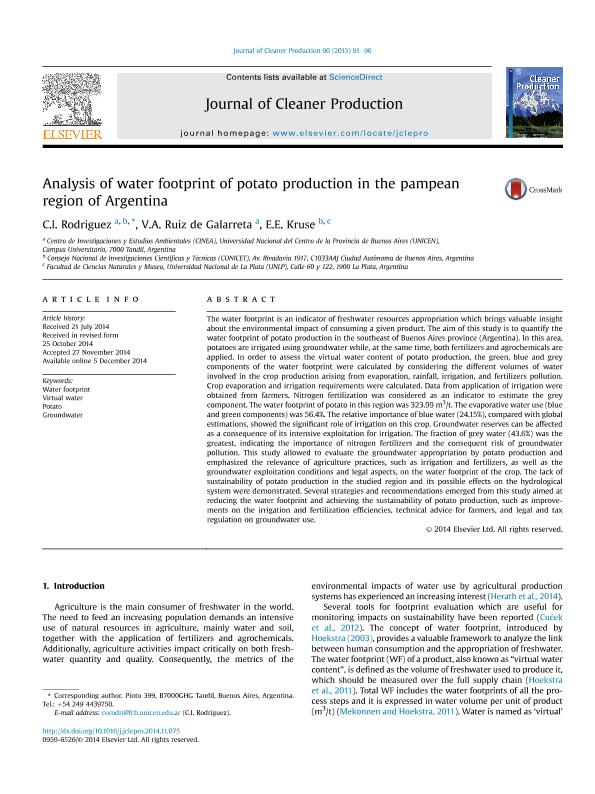Artículo
Analysis of water footprint of potato production in the pampean region of Argentina
Fecha de publicación:
03/2015
Editorial:
Elsevier
Revista:
Journal Of Cleaner Production
ISSN:
0959-6526
Idioma:
Inglés
Tipo de recurso:
Artículo publicado
Clasificación temática:
Resumen
The water footprint is an indicator of freshwater resources appropriation which brings valuable insight about the environmental impact of consuming a given product. The aim of this study is to quantify the water footprint of potato production in the southeast of Buenos Aires province (Argentina). In this area, potatoes are irrigated using groundwater while, at the same time, both fertilizers and agrochemicals are applied. In order to assess the virtual water content of potato production, the green, blue and grey components of the water footprint were calculated by considering the different volumes of water involved in the crop production arising from evaporation, rainfall, irrigation, and fertilizers pollution. Crop evaporation and irrigation requirements were calculated. Data from application of irrigation were obtained from farmers. Nitrogen fertilization was considered as an indicator to estimate the grey component. The water footprint of potato in this region was 323.99 m3/t. The evaporative water use (blue and green components) was 56.4%. The relative importance of blue water (24.15%), compared with global estimations, showed the significant role of irrigation on this crop. Groundwater reserves can be affected as a consequence of its intensive exploitation for irrigation. The fraction of grey water (43.6%) was the greatest, indicating the importance of nitrogen fertilizers and the consequent risk of groundwater pollution. This study allowed to evaluate the groundwater appropriation by potato production and emphasized the relevance of agriculture practices, such as irrigation and fertilizers, as well as the groundwater exploitation conditions and legal aspects, on the water footprint of the crop. The lack of sustainability of potato production in the studied region and its possible effects on the hydrological system were demonstrated. Several strategies and recommendations emerged from this study aimed at reducing the water footprint and achieving the sustainability of potato production, such as improvements on the irrigation and fertilization efficiencies, technical advice for farmers, and legal and tax regulation on groundwater use.
Palabras clave:
Groundwater
,
Potato
,
Virtual Water
,
Water Footprint
Archivos asociados
Licencia
Identificadores
Colecciones
Articulos(CCT - TANDIL)
Articulos de CTRO CIENTIFICO TECNOLOGICO CONICET - TANDIL
Articulos de CTRO CIENTIFICO TECNOLOGICO CONICET - TANDIL
Articulos(SEDE CENTRAL)
Articulos de SEDE CENTRAL
Articulos de SEDE CENTRAL
Citación
Rodriguez, Corina Iris; Ruiz de Galarreta, Victor Alejandro; Kruse, Eduardo Emilio; Analysis of water footprint of potato production in the pampean region of Argentina; Elsevier; Journal Of Cleaner Production; 90; 3-2015; 91-96
Compartir
Altmétricas




